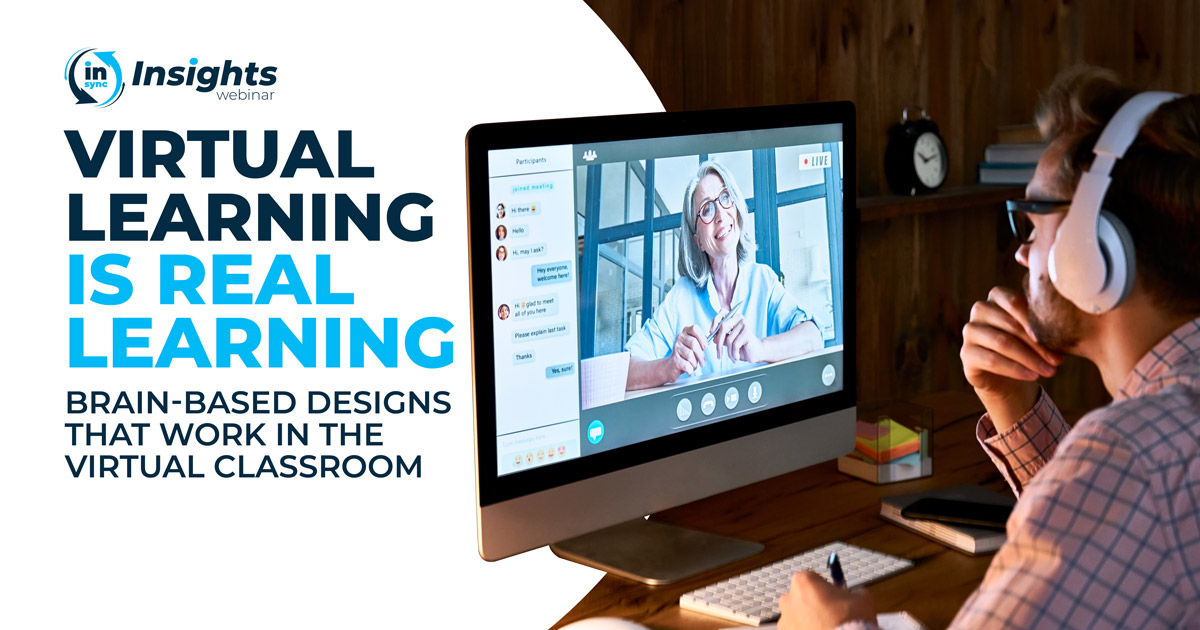2 min read
Elevate Virtual Training: Brain-Based Activity Design Webinar Recap
InSync Training : Sep 18, 2023 4:02:16 PM

Move From Webinars to True Active & Sustainable Learning Programs
Watch this InSync Insights Webinar recording where Karen Vieth, the Vice President of Virtual Learning Solutions, and Jennifer Hofmann, the Founder and President of InSync Training, explain how to design brain-based activities that engage learners and create active and sustainable virtual learning.
Scroll down for a short recap of the program or click on the graphic below to watch the replay.
In today's fast-paced corporate training landscape, virtual learning environments have become the norm. There is a significant challenge - how to fully engage participants and achieve desired learning outcomes. Too often, we rush to deliver virtual training, relying on slides and live videos as the primary means of learner engagement, leaving little room for genuine learning. But fear not, as we recently hosted an interactive webinar that delved deep into this issue and provided valuable insights on how to enhance your virtual training programs.
Our webinar emphasized the need for a more comprehensive and brain-based approach to virtual training, one that goes beyond presentations and encourages interactive and immersive virtual classrooms. The central question was: How do we address this problem effectively? The answer, as usual, was relying on strong instructional design.
The Power of Brain-Based Learning
One of the key takeaways from the session was the introduction of the Principles of Brain-Based Learning and their critical role in fostering effective learning transfer, application, and engagement. By understanding how the brain works, we can design virtual training programs that align with our natural cognitive processes, maximizing the impact of our efforts.
Three Essential Types of Engagement
To truly engage learners in a virtual setting, we need to consider three essential types of engagement: intellectual, environmental, and emotional. Intellectual engagement involves stimulating learners' thinking and problem-solving abilities, while environmental engagement considers the physical and digital surroundings that influence learning. Emotional engagement, on the other hand, focuses on creating a positive and motivating emotional atmosphere for participants. We need to engage students in all three ways to maximize online training results.
Captivating Activities for Virtual Training with Tools for Immediate Application
Our webinar didn't just stop at theory; we provided real world practical solutions as well. We introduced five captivating activities specifically designed for virtual training environments - from small group work to independent activities. We have designed these activities to add depth and interactivity to your sessions, ensuring that participants remain fully engaged throughout their virtual learning journey.
As a bonus, we guided participants through the process of designing an activity tailored to their next virtual class. This hands-on practice ensures immediate application of the concepts learned, making the knowledge gained in the webinar truly actionable.
Your Ongoing Success
To support your ongoing success in the realm of virtual training, participants received a link to download a detailed eBook titled Virtual Learning is Real Learning - 5 Activities for Your Programs. This comprehensive resource includes ready-to-use training materials that can be easily adapted to suit your specific needs. Furthermore, it provides explanations of how these materials engage learners with a brain-based foundation, enhancing the overall impact of your virtual training programs.
In summary, our webinar offered a holistic approach to elevating your virtual training programs. We explored the Principles of Brain-Based Learning, the importance of different types of engagement, and provided practical tools and activities to make your virtual classrooms active, sustainable, and impactful.
By applying the knowledge and insights gained from this session, you can transform your virtual training programs from mere webinars into true learning experiences that foster engagement, retention, and meaningful knowledge transfer. Don't miss out on the opportunity to take your virtual training to the next level – embrace the power of brain-based learning and create a virtual classroom that truly works.
There's More to Learn: Put Brain-Based Design into Action
Continue your personal learning journey with InSync Training by becoming a Master Virtual Classroom Designer and learn to:
- Transition from webinars to genuine learning experiences, designed for real engagement. Learn how to weave collaboration, accountability, and assessment into your programs to create rich learning experiences.
- Discover how to create comprehensive materials that enable your virtual facilitation team to apply adult learning principles and stimulate intellectual engagement.
- Facilitate authentic connections to foster emotional engagement, using technology to enhance environmental engagement.
- Access the full webinar recording here: Brain-Based Design
 Read More
Read More
![[Podcast] Virtual Learning: The Numbing Effects of the Information Age](https://blog.insynctraining.com/hubfs/chaffin_3d.png)
[Podcast] Virtual Learning: The Numbing Effects of the Information Age
Are You Bored Yet? Probably. Zoom fatigue is real. We live in a time of information and cognitive overload. And it's become worse since the Covid-19...

![[Podcast] Evaluating Hybrid and Virtual Learning](https://blog.insynctraining.com/hubfs/001_INS_WEB_IMAGES/podcast_360X180.jpg)